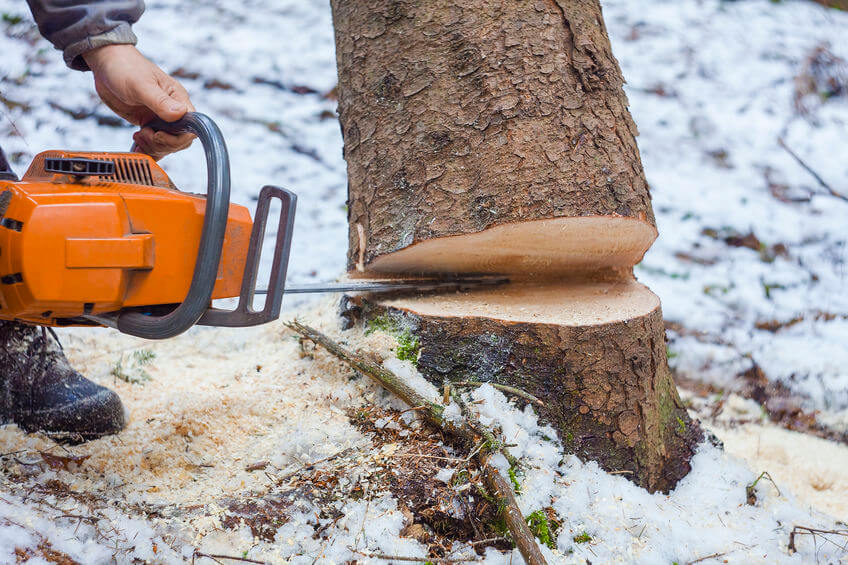- Home
- Heating With Wood
- Wilting Firewood
Wilting Firewood
This post may contain affiliate links so I earn a commission.
Wilting firewood is a term used by many people to describe the process of cutting down a live tree containing foliage and allowing the tree to lay on the ground for weeks or even months before removing the limbs and processing the wood.
That allows the tree to dry due to water loss.
So what's the purpose behind leaving the limbs and leaves intact and not cutting them off immediately?
In theory, the leaves will continue to draw moisture from the tree after it has been cut, drying the wood faster than other conventional methods.

Once the leaves turn brown, you remove the limbs and cut up the rest of the tree.
Does it actually work?
In order to fully understand the process, let's look at how a tree transports water and whether or not this is a viable option or just a myth.
Moisture Transportation in Trees
Think of a tree like a bunch of tiny tubes wrapped in a layer of bark.
These tiny tubes are made of wood fibers, and their job is to transport water and nutrients from the roots to the leaves.
There are two types of water found within a tree.
The water that flows throughout the tubes is called free water, while the water contained inside the fibrous tubes themselves is known as bound water.
Free water evaporates much easier than bound water because free water is not held chemically within the fibers, unlike bound water that's held by hydrogen bonding.
Wilting Firewood
The theory behind wilting firewood is that the leaves will draw out a majority of the free water from the tree after it has been cut down.
Since the bound water is much harder to remove, it will still remain in the tree.
However, the absence of free water will reduce the overall moisture content in the wood, thus making the wilting process a success.

There are many different opinions and schools of thought regarding this process.
Although just about everyone (including myself) agrees that wilting does work to some extent, the question is how much moisture is actually removed from the inner heartwood of the trunk as opposed to just the sapwood or the branches?
Unfortunately, there are no studies (that I'm aware of) that show exactly how well the process works.
Plus, with multiple variables, it would be hard to come up with a conclusive answer.
There is one thing that we do know for sure.
There is no substitute for time, wind, and the sun when it comes to drying firewood, especially when it's accompanied with proper storage.
Planning ahead and allowing sufficient time is always the best way.
If you find yourself running short on time or you're "behind the eight-ball" with your firewood processing, I believe wilting firewood does help to some extent.

I've done it several times, and I think it does make a difference.
However, just don't expect the wood to be stove ready after it's been lying on the ground for a month or two.
The Best Ways to Dry Firewood Aside From Wilting
Pick the correct season to dry your firewood, ensuring there's enough time for your wood to fully dry.
It is best to cut the firewood during spring or early summer.
Different types of firewood have different drying periods.
Cutting the firewood into the right length and splitting the rounds into small pieces gives it a broader surface area for drying.
The length you cut your firewood is usually dependent on the size of your wood stove's firebox.
Cutting the wood too short means you're not using valuable space inside the firebox, but cutting the wood too long means the logs won't fit.

Arranging the firewood in a row and lifting them off the earth ensures that the breeze and sun can dry off the firewood from the cut ends by drawing out the moisture.
If your firewood is too wet, it produces little to no heat and plenty of smoke.
The usual moisture content of freshly cut wood ranges from 30-50%.
Your firewood moisture content should be as low as 15-20% for an efficient burn.
5 Ways to Determine if the Wood is Dry After Wilting Firewood
Compared to freshly cut wood, dry firewood is lighter in weight and has a bleached color and an easy-to-peel bark.
At the edges, the wood grains may have cracks depending on the wood.
Compared to when it is freshly cut, the cut-off end will feel dry and warmer.
When two wood pieces are thumped together, the sound will be hollow when dry.
When wet, it will make a dull thump.
Within a minute, when dry firewood is thrown into a bed of glowing hot coals, it will catch fire.
If wet firewood is thrown, it sizzles and smoke, released unburnt gasses up the chimney where they form creosote.
Comparison Between Hardwood and Softwood After Wilting Firewood
Hardwoods are usually heavier than softwoods after wilting and have a longer seasoning and drying time.
Hardwood reproduction entails delicious seeds with a covering, such as an apple or acorn.
Compared to softwood after wilting, hardwood takes a longer time to burn and produces the most heat.

However, even if hardwood is usually heavier than softwood, some hardwood, such as basswood, is light making it easy to work with.
The softwood seeds have no covering; the softwoods are evergreen, for example, pine trees.
Softwoods are easy to split after wilting, and they have a shorter drying period.
They burn faster than hardwood; hence for the same amount of heat, twice as much softwood is required.
Using softwood at the firebase assists makes it easy for the fire to start, and filling up with hardwood ensures that the fire lasts a longer period.

About the Author
Obsessed with firewood, Nick is behind over 350+ of Firewood For Life's articles, as well as countless reviews, guides and YouTube videos to help readers like you reduce heating costs and create the perfect fire.


